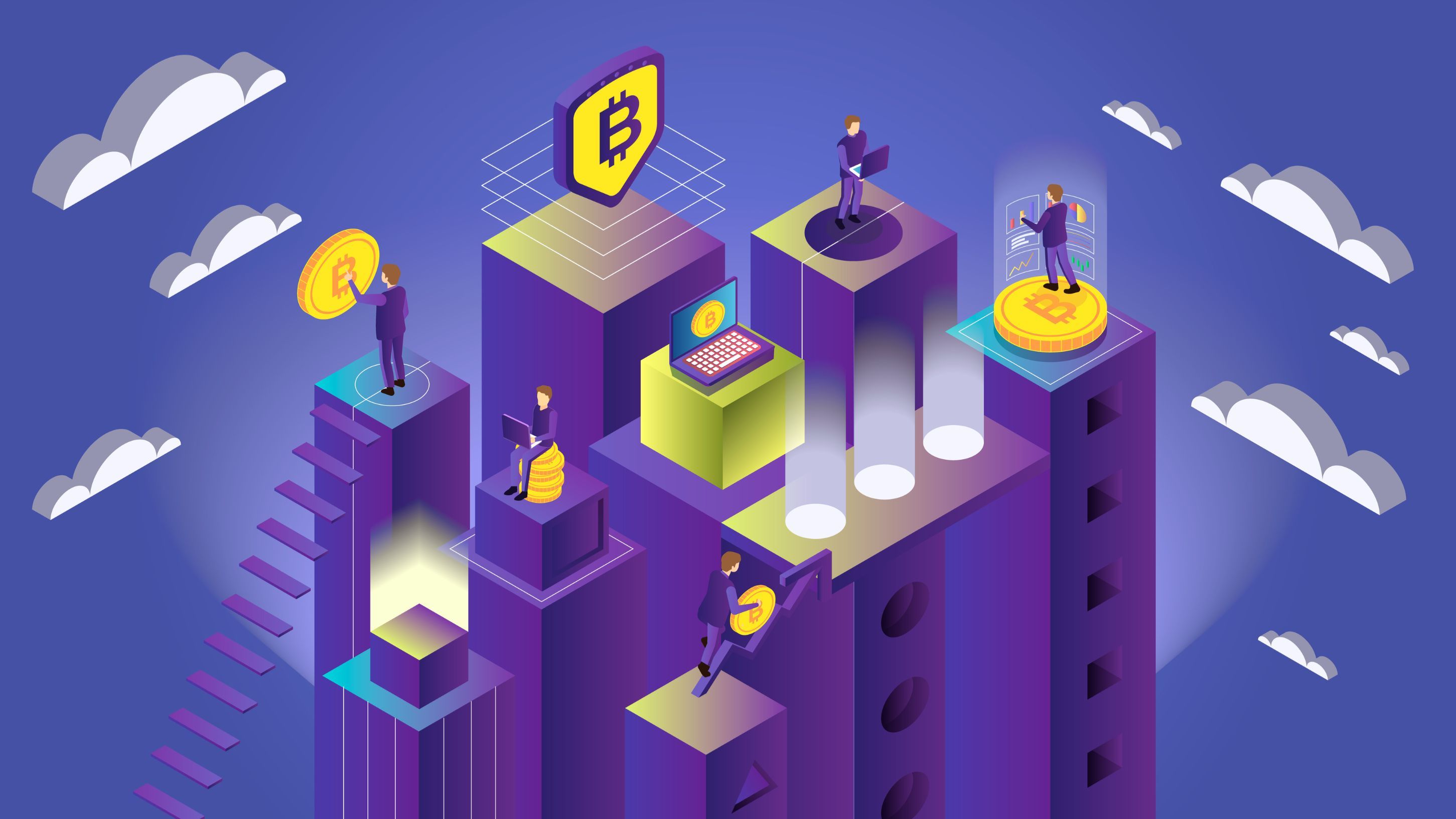Blockchain has come a long way since it first emerged, revolutionizing industries like finance, healthcare, and beyond. Now, as we stand at the brink of Blockchain 4.0, the big question is: what’s next?
We’ve already witnessed how each generation of blockchain has brought exciting new changes.
Blockchain 1.0 introduced us to Bitcoin and simple digital transactions, marking the start of decentralized currency. Blockchain 2.0 followed by bringing smart contracts, which allowed for automated agreements without the need for intermediaries. Then, Blockchain 3.0 tackled major challenges like scalability and interoperability, making the technology faster, more flexible, and more connected than ever before.
Now, with Blockchain 4.0 on the horizon, it’s clear that we’re about to enter a whole new era of possibilities.
But what exactly will Blockchain 4.0 bring to the table? How will it build on the successes—and solve the limitations—of the previous versions? And more importantly, how will it reshape industries, solve real-world problems, and change the way we live and work?
In this article, we’ll explore these questions and take a closer look at how the next generation of blockchain could truly transform our digital landscape.
What is Blockchain - A Simple Yet Technical Explanation
Blockchain is a shared digital ledger that records transactions across a network of computers. Each transaction is grouped into a "block," and these blocks are linked in sequence, forming a chain. This setup makes the data extremely secure because altering any block would require changing all subsequent blocks on every computer in the network.
The technology works without needing a central authority, allowing peer-to-peer transactions without intermediaries like banks. It’s powered by multiple computers (nodes) that verify transactions, ensuring the system remains transparent and resistant to tampering.
While blockchain started with cryptocurrencies like Bitcoin, it’s now used in industries like finance, healthcare, and supply chain management to improve security, efficiency, and transparency in various processes.
The Four Eras of Blockchain: From Bitcoin to Enterprise
Blockchain has come a long way since Bitcoin. Each era has added new features, transforming it from digital currency to a tool for global industries.
Here’s a quick look at how blockchain evolved across four generations:
Blockchain 1.0: The Beginning of Digital Currency (Bitcoin Era)
Blockchain 1.0 marks the introduction of decentralized digital currency, primarily through Bitcoin, which was created in 2009 by an anonymous figure known as Satoshi Nakamoto. The main breakthrough here was the concept of a distributed ledger, a secure, shared record of transactions. Instead of relying on banks or governments to verify transactions, Bitcoin uses a network of computers (nodes) to confirm and record each transaction, ensuring it’s transparent and secure.
However, Blockchain 1.0 was mostly focused on cryptocurrency transactions. The system was somewhat slow—handling only a few transactions per second—and required significant energy due to its proof-of-work mechanism, where computers solved complex puzzles to validate transactions. This laid the foundation for digital payments but was still limited in what it could do beyond currency.
Blockchain 2.0: Smart Contracts and Decentralized Applications (Ethereum Era)
Blockchain 2.0 expanded the use of blockchain beyond currency with the invention of smart contracts. These are self-executing contracts where the terms are written directly into code. The most significant development came with Ethereum, launched in 2015 by Vitalik Buterin. Ethereum’s platform allowed developers to build decentralized applications (dApps) and smart contracts that automatically execute when the conditions are met, without needing intermediaries like lawyers or banks.
For example, if you rent a car using a smart contract, it could release the keys only when payment is made, and the transaction is recorded on the blockchain for transparency. This opened up new possibilities for decentralized finance (DeFi), gaming, supply chain management, and more. While Ethereum brought new functionalities, it still faced issues with speed and scalability, especially as the number of users grew.
Blockchain 3.0: Improving Scalability, Speed, and Interoperability
Blockchain 3.0 came about in response to the limitations of previous generations, particularly around scalability (handling more transactions), speed, and interoperability (making blockchains work together). Early blockchains like Bitcoin and Ethereum could only process a limited number of transactions per second, which made them slow for large-scale use. Additionally, each blockchain operated in isolation, unable to communicate easily with others.
Blockchain 3.0, led by projects like Polkadot, Cardano, and EOS, solved some of these issues. Polkadot, for example, introduced interoperability by allowing different blockchains to share data and assets with each other. Meanwhile, platforms like Cardano used more efficient consensus mechanisms like proof-of-stake (PoS) to make validation faster and less energy-intensive. These improvements made blockchain technology more practical for widespread applications, from managing global supply chains to supporting decentralized finance (DeFi) platforms.
Blockchain 4.0: Optimized for Industry and Enterprise
Blockchain 4.0 represents the move toward enterprise-ready blockchain technology. It’s designed to be fast, highly scalable, and able to integrate with existing business systems. This generation is built with industries like finance, healthcare, logistics, and government in mind, focusing on providing solutions that can handle large-scale transactions and data with ease.
Blockchain 4.0 also places a strong emphasis on privacy, allowing businesses to keep sensitive information confidential while still benefiting from the security and transparency of blockchain. It integrates seamlessly with other modern technologies, such as Artificial Intelligence (AI) and the Internet of Things (IoT), making it possible to automate complex tasks across industries. For example, a hospital might use blockchain to securely track patient data across different departments, while a logistics company could automatically manage shipments using IoT sensors connected to a blockchain network.
Platforms like Hyperledger and Vechain are examples of Blockchain 4.0 solutions that offer specialized tools for industries to build customized blockchain systems, ensuring they meet their unique needs.
The Five Key Innovations of Blockchain 4.0: What Sets It Apart
Blockchain 4.0 is transforming how businesses use decentralized technology. It focuses on speed, integration, privacy, automation, and sustainability, making it ideal for large-scale applications.
Here are the five key features that distinguish Blockchain 4.0 and why they matter for the future of industries.
Enterprise-Ready Speed and Scalability
With the power to handle thousands of transactions per second, this version is perfect for industries like finance and logistics that need fast, high-volume processing. It fixes the slowdowns and scalability issues of older blockchains, ensuring businesses can operate smoothly even at large scales.
Seamless Integration with Existing Systems
Designed to easily plug into existing business setups, this version makes adopting blockchain tech much simpler. Companies can enhance processes like payments, data sharing, and supply chain management without overhauling their entire infrastructure, making the transition smoother and more efficient.
Advanced Privacy and Security Features
With better privacy controls, sensitive business data stays protected while still benefiting from blockchain’s transparency and security. This is a big deal for industries like healthcare and finance, where data protection is crucial, allowing them to keep private info secure without compromising on security.
Smart Automation with AI and IoT
This version works well with AI and IoT, making it easy for businesses to automate processes and manage things in real time. From tracking inventory to optimizing energy use, companies can streamline their operations and improve efficiency without needing constant manual input.
Energy Efficiency and Sustainability
Thanks to energy-efficient mechanisms like proof-of-stake, this blockchain uses way less energy than older models. It's a big step toward greener technology, addressing the environmental concerns of previous blockchains while still being fast and effective for large-scale use.
Blockchain 4.0 is a revolution for industries. It enables faster, smarter, and more efficient business operations. With its focus on scalability, privacy, and automation, it will drive the next wave of digital transformation, creating a more sustainable and connected world.
10 Real-World Applications of Blockchain 4.0: How It Can Transform Industries
Blockchain 4.0 is here to change the way industries operate by offering better speed, scalability, security, and automation. It’s designed to integrate smoothly with current systems while handling high volumes of transactions, making it perfect for large-scale applications.
Let’s explore 10 real-world applications where Blockchain 4.0 can make a significant impact, explaining how it works and what it can achieve if properly invested in.
Cross-Border Payments and Remittances
Cross-border payments are slow and expensive, but Blockchain 4.0 can fix that. By processing transactions in real-time and with minimal fees, it cuts out intermediaries like banks. Blockchain 4.0 can handle thousands of transactions per second, so international transfers become nearly instant. Smart contracts automate everything, ensuring that funds are transferred quickly and securely without human error. For global remittances and international businesses, Blockchain 4.0 makes payments faster, cheaper, and more reliable.
Digital Identity Management
Centralized identity systems are vulnerable to hacking and fraud. Blockchain 4.0 provides decentralized digital identities that give users full control over their information. Instead of relying on a single entity to verify your identity, Blockchain 4.0 creates an immutable, unique record that you control. You can selectively share your data with businesses, governments, or services while keeping your information private and secure. This application could drastically improve identity management in sectors like banking, healthcare, and government services by reducing identity theft and increasing security.
Automated Supply Chain Management
Blockchain 4.0 can revolutionize supply chains by making them more transparent and efficient. Through the use of IoT sensors, goods can be tracked in real time from production to delivery, with each step recorded immutably on the blockchain. Smart contracts can automate payments and update records automatically once certain conditions, like reaching a specific warehouse, are met. This reduces manual work, speeds up operations, and ensures product authenticity. Blockchain 4.0 is especially useful for industries like pharmaceuticals and food, where transparency and traceability are critical for safety and compliance.
Decentralized Finance (DeFi)
DeFi has already made waves, but Blockchain 4.0 takes it to the next level. With the ability to process large numbers of transactions quickly and securely, Blockchain 4.0 makes decentralized financial services more accessible. It supports smart contracts for automated loans, trades, and investments, all without the need for traditional banks. Tokenizing assets like real estate or commodities becomes easier, enabling fractional ownership. Blockchain 4.0 makes financial services faster, more secure, and far more inclusive for a global audience.
Healthcare Data Sharing and Security
Healthcare data is often scattered across different systems, making it hard to share between providers while keeping it secure. Blockchain 4.0 offers a decentralized solution that allows patient data to be securely shared between hospitals, doctors, and insurers, while ensuring that only authorized parties have access. Patients control who sees their data and when. The blockchain’s privacy features ensure that sensitive information remains protected while also allowing seamless, secure data sharing that can improve care quality and efficiency.
Real Estate Transactions
Buying or selling real estate is typically a slow process involving multiple intermediaries. Blockchain 4.0 can streamline this by using smart contracts to automatically handle agreements and payments. Once conditions are met, like the buyer securing financing, the smart contract executes the sale, transfers ownership, and releases funds instantly. This eliminates the need for brokers or escrow services, reducing time and costs. Blockchain also ensures that ownership records are immutable, reducing fraud and simplifying the transfer of property. Tokenized real estate could also allow for fractional ownership, making real estate investment more accessible.
Transparent Voting Systems
Blockchain 4.0 can ensure secure and transparent voting systems. Votes can be immutably recorded on the blockchain, preventing any tampering or fraud. This kind of system can verify voters' eligibility while ensuring anonymity, giving people confidence that their votes are counted accurately. The speed and security of Blockchain 4.0 make it ideal for national elections, organizational voting, or even community decision-making, where transparency and trust are crucial.
Intellectual Property Protection
For creators, protecting intellectual property (IP) can be challenging. Blockchain 4.0 provides a way to securely register and timestamp creative works—whether it's music, art, patents, or inventions. This provides irrefutable proof of ownership that cannot be altered. Smart contracts can also automate royalty payments, ensuring that creators get paid whenever their work is used, without the need for intermediaries. This is particularly useful in industries like entertainment, publishing, and tech, where copyright disputes are common and protecting IP is essential.
Energy Trading and Smart Grids
Blockchain 4.0 can power peer-to-peer energy trading by allowing consumers to sell surplus energy directly to others on the grid. Using smart meters and IoT devices, energy flows can be tracked and traded automatically based on demand. This creates a decentralized, efficient energy market. Blockchain 4.0’s low-energy consensus mechanisms like proof-of-stake ensure that the system remains sustainable. Governments and utility companies could use this technology to build smart grids that are more resilient and responsive to fluctuations in supply and demand.
Insurance Claims Automation
Filing insurance claims can be a long, tedious process. Blockchain 4.0 can change that by using smart contracts to automatically process claims. For instance, if a flight is delayed, the smart contract could instantly verify the delay and issue compensation to the traveler. This takes out the need for paperwork and manual checks. Blockchain’s transparency ensures that all claim details are stored securely, reducing fraud and disputes. Insurance companies can also use blockchain to automate underwriting, policy issuance, and auditing, making the entire process more efficient and reducing costs.
Blockchain 4.0 is set to transform industries by enabling faster, more efficient, and secure operations. With proper investment, it has the potential to drive innovation and revolutionize business processes globally.
Challenges and Considerations for Implementing Blockchain 4.0
While Blockchain 4.0 brings immense potential for transforming industries, it’s important to recognize that the road to widespread adoption isn’t without its challenges. Understanding these obstacles and how to navigate them is crucial for businesses looking to invest in and implement this next generation of blockchain technology. Here are some key challenges and considerations:
Scalability vs. Infrastructure Costs
Blockchain 4.0 is designed to handle thousands of transactions per second, making it far more scalable than earlier versions. However, scaling up a blockchain network requires significant computational resources and infrastructure investment. Large enterprises will need to invest heavily in the infrastructure required to support Blockchain 4.0, such as servers, network bandwidth, and secure data centers. These costs can be prohibitive for smaller businesses, limiting adoption to those who can afford the necessary technology. Additionally, maintaining and upgrading blockchain networks over time can add to long-term costs, making scalability a balancing act between performance and financial investment.
Regulatory Uncertainty
One of the biggest challenges facing Blockchain 4.0 is the regulatory landscape, which varies greatly between countries. Blockchain operates in a decentralized manner, often bypassing traditional financial and institutional systems, which creates uncertainty about how governments will regulate it. Industries like finance, healthcare, and energy, which are heavily regulated, could face delays in adopting Blockchain 4.0 due to ambiguous legal frameworks. Regulatory bodies may be cautious about how blockchain technologies handle data privacy, cross-border transactions, and taxation. Businesses will need to keep a close eye on emerging regulations and be prepared to adjust their blockchain strategies to remain compliant.
Integration with Legacy Systems
Many industries rely on legacy systems that have been in place for decades. Integrating Blockchain 4.0 with these systems can be technically complex and time-consuming. Blockchain, with its decentralized architecture, operates differently from traditional centralized databases and infrastructures, making compatibility a significant issue. Existing systems might need extensive modifications or entirely new interfaces to communicate with blockchain networks. This creates challenges not only in terms of technical integration but also in managing downtime and data migration during the transition. Companies must also train staff on new systems, adding to the implementation timeline and costs.
Data Privacy and Compliance Concerns
While blockchain is known for its transparency, businesses in sectors such as healthcare and finance must adhere to strict data privacy regulations like HIPAA and GDPR. Blockchain’s immutable nature means that once data is recorded, it cannot be changed or deleted, raising concerns about data protection and right-to-be-forgotten laws. Blockchain 4.0 offers privacy-enhancing features, but businesses will need to implement these carefully to remain compliant with legal standards. Navigating how to handle sensitive personal information while maintaining compliance is a significant challenge for enterprises that want to leverage blockchain for data management.
Skill Gaps and Workforce Readiness
The implementation of Blockchain 4.0 requires a skilled workforce capable of designing, developing, and maintaining blockchain systems. However, there is currently a shortage of blockchain experts, making it difficult for businesses to find the talent needed for implementation. This skill gap means that companies might need to invest in upskilling their current workforce or hiring specialized developers and engineers with blockchain expertise, which can be costly and time-consuming. Moreover, businesses may face resistance from staff unfamiliar with decentralized technologies, requiring additional training programs to ensure smooth adoption.
Overcoming the Challenges of Blockchain 4.0 Implementation
Despite these challenges, the potential of Blockchain 4.0 is too significant to ignore.
Businesses that strategically invest in infrastructure, navigate regulatory frameworks, and ensure proper integration with legacy systems can reap substantial benefits. Addressing data privacy concerns and bridging the skill gap with blockchain education will be critical for driving successful implementation.
As companies move toward decentralization and automation, overcoming these obstacles will position them to lead in the rapidly evolving digital landscape powered by Blockchain 4.0.
The Road Ahead for Blockchain 4.0
As Blockchain 4.0 evolves, it will not only address current limitations but also pave the way for a new era of decentralized technology. The innovations outlined—interoperability, quantum-resistant security, DAOs, AI integration, wider public adoption, and sustainability—are just a glimpse of what's to come. Businesses that stay ahead of these trends and invest in Blockchain 4.0’s development will be well-positioned to capitalize on the next wave of digital transformation.
Interoperability Between Blockchains
One of the most critical developments on the horizon for Blockchain 4.0 is interoperability—the ability for different blockchain networks to communicate and share data seamlessly. Currently, many blockchains operate in isolation, limiting their use across multiple platforms. Interoperability will enable various blockchain ecosystems, such as Ethereum, Polkadot, and Cardano, to work together, allowing data transfer and asset exchange across chains. This development will be crucial for industries that rely on multiple blockchains, creating greater flexibility and collaboration between decentralized networks.
Future projects like cross-chain bridges and blockchain interoperability protocols will make it possible for businesses to manage assets and data across multiple platforms, unlocking new opportunities for collaboration, supply chain management, and global finance.
Quantum-Resistant Security
With the advancement of quantum computing, traditional cryptographic methods used in blockchain could become vulnerable to hacking. As quantum computers gain the ability to solve complex problems exponentially faster than current systems, they pose a significant threat to blockchain’s security models, particularly public-key cryptography.
To combat this, the future of Blockchain 4.0 will focus on developing quantum-resistant algorithms. These new cryptographic methods will protect blockchain networks from potential quantum attacks, ensuring that transactions and data remain secure in a quantum-powered world. Companies are already investing in post-quantum cryptography, and integrating these solutions will be a major focus for blockchain security in the years ahead.
Decentralized Autonomous Organizations (DAOs)
The rise of Decentralized Autonomous Organizations (DAOs) is set to change how businesses and organizations operate. DAOs are self-governing entities that run on smart contracts, allowing stakeholders to vote on decisions without the need for a centralized authority. Blockchain 4.0 enhances DAOs by offering faster and more scalable smart contract platforms, allowing for greater efficiency in managing decentralized organizations.
In the future, we can expect DAOs to expand beyond small, niche communities into more mainstream industries. Companies could use DAOs to manage shareholder voting, business governance, and even supply chain management. This evolution in decentralized governance could lead to a new era of transparent, democratic decision-making, with Blockchain 4.0 providing the infrastructure for these self-operating entities.
Blockchain and AI Integration
As Artificial Intelligence (AI) continues to advance, its integration with blockchain technology will create new possibilities for automated, intelligent systems. Blockchain 4.0’s ability to handle high volumes of data in a decentralized manner pairs well with AI’s data-driven decision-making capabilities. Together, they will enable smarter contracts, predictive analytics, and real-time optimizations across various industries.
For instance, AI-driven supply chains can be powered by Blockchain 4.0 to automate complex logistics, using real-time data to make decisions about inventory, routes, and demand forecasting. Additionally, AI can enhance blockchain’s security by identifying anomalies and potential threats faster than human monitoring. As blockchain and AI continue to merge, the possibilities for intelligent automation and predictive business processes will expand, creating more efficient and responsive industries.
Wider Adoption in Public Services
Blockchain’s potential to improve transparency and efficiency in public services is increasingly recognized by governments around the world. In the future, Blockchain 4.0 is expected to play a significant role in areas such as digital identities, public records management, and government accountability. For instance, blockchain could be used to create secure digital IDs, allowing citizens to access government services, vote, and manage personal data in a decentralized manner.
Blockchain-based voting systems will also gain traction, providing tamper-proof election results and restoring public trust in the voting process. Additionally, governments may use blockchain to manage land registries, tax collection, and social welfare programs, ensuring transparent and efficient public service delivery. Wider adoption of Blockchain 4.0 in public services could lead to more efficient governance, reduced corruption, and greater transparency.
Sustainability Improvements
As concerns over energy consumption grow, particularly with proof-of-work blockchains like Bitcoin, the future of Blockchain 4.0 will focus heavily on sustainability. Blockchain 4.0 already employs energy-efficient consensus mechanisms like proof-of-stake (PoS), which significantly reduces the power needed to validate transactions. However, there’s room for further innovation to make blockchain networks even more eco-friendly.
Future advancements may include hybrid consensus models that combine the security of proof-of-work with the efficiency of proof-of-stake, or entirely new mechanisms that minimize energy usage without sacrificing security. Additionally, blockchain could be leveraged in sustainability-focused projects like carbon tracking, green energy trading, and environmental reporting, making Blockchain 4.0 not only more energy-efficient but also a key player in the global push toward sustainability.
How Can Businesses Get Ready For Blockchain 4.0?
Getting your business ready for Blockchain 4.0 starts with figuring out where it can make the biggest difference. Look for areas where blockchain can automate processes, boost transparency, or improve security, like speeding up payments or tracking products in real time. By identifying these key areas, you can focus on implementing blockchain where it truly adds value.
Next, you'll need the right talent. Whether it's upskilling your current team or bringing in blockchain experts, make sure your workforce is ready to handle this new tech. A great way to start? Run small pilot projects. This lets you test how blockchain works in your business without fully diving in. Helping you learn what works before scaling up.
Finally, don’t overlook compliance and security. Blockchain is powerful, but it needs to meet industry regulations and keep your data safe. Tackle these early on, and you’ll ensure a smooth, secure transition into the world of Blockchain 4.0.
Final Thoughts
Blockchain 4.0 is set to change industries in powerful ways, offering more efficiency, transparency, and security than ever before. This next phase of blockchain technology goes beyond what we've seen, enabling automation, decentralized control, and new business models that could reshape entire sectors.
The real opportunity for businesses is in knowing where blockchain can truly make a difference.
It's not just about adopting the technology, but applying it strategically to solve real problems and spark innovation. By working with a skilled blockchain development company, businesses can create custom solutions that meet their unique needs and help them stay ahead of the competition.
Now is the time to act, not just to keep up, but also, to lead.
Those who embrace blockchain today will help shape the future of decentralized systems and position themselves as leaders in this new digital age.
















